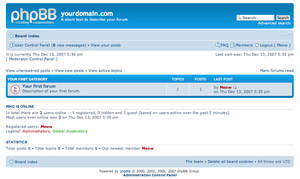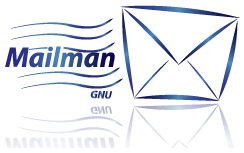Web archive
Sympa maintains web archive for mailing lists that have the feature enabled. The web archives are fully integrated in the Sympa web interface, though the engine that does the HTML tranformation is an third-party tool, MHonArc.
...
vs
---- немає "вбудованого" --- позиціонується паблік "Mail-archive: http://www.mail-archive.com/ Home of the official Mailman-* mailing list searchable archives.." ))
1.11. How do I make the archives searchable
The archives (unless made explicitly private) are indexable and searchable by standard web search tools (for example you could encourage google to index your archive pages and then do searches with google restricting results to your domain).
eg Search google for, "clever technique site:your.domain.dom"
But you should note that Google does not index all your posts, especially the recent posts which have not yet been crawled and indexed yet. An alternative is to use a third-party mailing list archive service which usually index your messages up to the minute. These services are usually free, although some may run Google ads. Below is a list of providers:
Mail-archive: http://www.mail-archive.com/ Home of the official Mailman-* mailing list searchable archives, they also run Google ads.
******
порівняння з форумним ПЗ
Internet forum
An Internet forum, or message board, is an online discussion site where people can hold conversations in the form of posted messages.[1] They differ from chat rooms in that messages are at least temporarily archived. Also, depending on the access level of a user or the forum set-up, a posted message might need to be approved by a moderator before it becomes visible.
Forums have a specific set of jargon associated with them; e.g. a single conversation is called a "thread".
....
Comparison with other web applications
Electronic mailing lists: The main difference between forums and electronic mailing lists is that mailing lists automatically deliver new messages to the subscriber, while forums require the reader to visit the website and check for new posts. Because members may miss replies in threads they are interested in, many modern forums offer an "e-mail notification" feature, whereby members can choose to be notified of new posts in a thread, and web feeds that allow members to see a summary of the new posts using aggregator software. There are also software products that combine forum and mailing list features, i.e. posting and reading via email as well as the browser depending on the member's choice.
було таке колись..
*****THEORY
Internet >
Mailing Lists
net.usenix In the letter from John Donnelly regarding the Boston Meeting, he mentioned the funding of a newsletter for Usenix. I just want to put in my bid for an "electronic newsletter" and not a physical (paper) one. It would seem to be a waste of paper and stamps to not take advantage of the net for distribution... |
net.usenix News about ";login:", the USENIX Association Newsletter, will follow. |
Mailing lists multiply the power of email by enabling you to send a message to many people across the Internet who are interested in the same subject, and enables readers to monitor interesting discussions on several subjects at once with automated assistance and little effort.
Anyone with email access can subscribe to mailing lists on subjects they find interesting and obtain free, peer-reviewed, up-to-date information not available anywhere else. The following sections provide more information:
- Managing mailing lists
- Filtering
- Configuration
- Searching for lists
- Set up your own mailing list
- Well known mailing lists
- Archives
- One-to-many communication
- Confidentiality
- Review
- Redistribution
- Archiving
Many list commands are described in this section, so you may wish to review the section on notation describing conventions about command placeholders and options.



